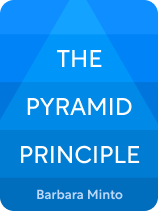

This article is an excerpt from the Shortform book guide to "The Pyramid Principle" by Barbara Minto. Shortform has the world's best summaries and analyses of books you should be reading.
Like this article? Sign up for a free trial here.
What is Barbara Minto’s best writing advice? How can her suggestions help you?
In The Pyramid Principle, Barbara Minto shares a form of writing called the Conclusions-First Pyramid. She developed this writing approach when she noticed that her colleagues were producing unclear reports that failed to reflect the strength of their ideas.
Learn more about Minto’s writing style below.
Barbara Minto on Writing
According to Minto, writing that is clear requires two approaches: a peak-to-base approach and a base-to-peak approach. The first approach has you fill out the pyramid from the top down. Minto recommends using the peak-to-base approach if you’ve already formulated an answer (the Peak Conclusion). By contrast, the base-to-peak approach has you fill out the pyramid from the bottom up. Use this approach if you haven’t yet brainstormed a Peak Conclusion or if the peak-to-base approach didn’t work for you.
(Shortform note: Although Minto presents a peak-to-base approach and a base-to-peak approach as a choice between two options, one expert on writing argues that you might use both approaches if your writing piece involves research (for instance, if you’re writing an opinion piece). In this case, you might begin by using an approach similar to Minto’s peak-to-base approach: You generate a main conclusion, then you develop details to support it. However, while conducting research to find these supporting ideas, you may discover that your original conclusion no longer matches the evidence. To remedy this, use a base-to-peak approach: Revise your Peak Conclusion to reflect what your researched evidence reveals.)
Here, we’ll further explain how to use each approach.
Approach 1: The Peak-to-Base Approach
Minto claims that when you already have your Peak Conclusion in mind, you can generate your remaining ideas by imagining you’re having a dialogue with a skeptical reader: someone who asks follow-up questions about each idea in your pyramid, starting at the peak. Your answers to their questions about the Peak Conclusion will become your Tier 1 ideas. If they continue to have questions about your Tier 1 ideas, you’ll answer those questions in Tier 2. Continue this process of adding tiers to your pyramid until you answer all of the skeptical reader’s questions.
For example, imagine a skeptical reader encounters your Peak Conclusion for the composting email: “You should compost.” They’ll most likely wonder, “Why?” The diagram below illustrates how your answers to this question form the conclusions in Tier 1. A skeptical reader would likely continue to have questions about these Tier 1 ideas. You can find the answers to those questions in Tier 2.
(Shortform note: It might be easier to use Minto’s strategy of generating ideas through questions and answers if you enlist the help of someone to play the role of the skeptical reader. Brainstorming with someone else can help you generate more ideas and clarify your existing ideas. Find a friend, colleague, family member, or mentor who’s willing to be your skeptical reader and willing to have their voice recorded. Instead of imagining the question-and-answer dialogue with a reader, have that dialogue with the person who’s helping you. Later, listen to the audio recording and transcribe your ideas into the pyramid format.)
Approach 2: Base-to-Peak Approach
According to Minto, a base-to-peak approach is a strong alternative to the peak-to-base approach, especially if you’re having trouble formulating your Peak Conclusion and/or your Tier 1 conclusions. To use the base-to-peak approach, follow these four steps:
Step 1: List ideas that answer your audience’s question. For example, in response to the question, “Should I compost?”, generate two lists: one list with reasons why a reader should compost, and one list with reasons why they shouldn’t compost.
(Shortform note: List-making is a helpful technique for generating ideas, and many experts claim that you should prioritize generating a large quantity of ideas over generating only quality ideas. When quantity is your focus, your ideas flow freely and you’re more likely to generate original, thoughtful ideas. When quality is your focus, there’s a risk your inner critic will stifle your creativity and you’ll end up with fewer strong ideas in your list.)
Step 2: Group your ideas based on their similarities. For instance, imagine you generated these four reasons why your reader should compost:
- The city will convert your organic waste into compost you can use in your garden.
- You’ll be entered into a raffle for a gift card to the gardening store.
- Using compost in our garden will reduce greenhouse gas emissions.
- Composting will divert our organic waste from landfills.
The first and second ideas are both reasons why composting benefits the individual reader. The third and fourth ideas are both reasons why composting benefits the community.
(Shortform note: A variety of techniques can assist you with grouping your ideas. One technique, called mind mapping, involves writing ideas in circles and drawing lines to connect ideas that are thematically related. Another technique is to use a highlighter to color-code your list items based on the similarities they share.)
Step 3: Generate a conclusion for each group and insert them into your pyramid. For example, this conclusion summarizes the first group of ideas: “Composting benefits you.” The conclusion summarizes the second group of ideas: “Composting benefits the community.” Write these conclusions in Tier 1, and write the specific supporting ideas from Step 2 in the tier below these conclusions.
Step 4: Generate a Peak Conclusion from your group conclusions. For example, write “You should compost” at the top of your pyramid.
(Shortform note: In How to Take Smart Notes, Sönke Ahrens argues that a bottom-up (or base-to-peak) approach offers an advantage over a top-down (or peak-to-base) approach: It prevents you from activating your confirmation bias. This bias is the tendency to search for and favor information that supports your existing beliefs. According to Ahrens, when you’re using a top-down or peak-to-base approach that has you form a conclusion first, you’ll only look for supporting evidence that confirms your conclusion—which could be an issue if your conclusion is wrong. By contrast, when you use a bottom-up or base-to-peak approach that has you wait to form a conclusion, you’re more likely to consider a wider variety of evidence and viewpoints and reach a more accurate conclusion.)

———End of Preview———
Like what you just read? Read the rest of the world's best book summary and analysis of Barbara Minto's "The Pyramid Principle" at Shortform.
Here's what you'll find in our full The Pyramid Principle summary:
- How to write so clearly that you can get a point across within 30 seconds
- How to write a clear, compelling introduction, body, and conclusion
- Why you should always start your prose with your conclusion and work backward






